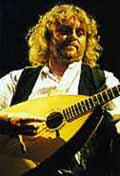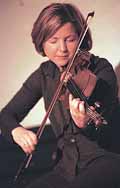 |
||
The Living Tradition
|
|
|||
| A
Bankie Lad -
by Ian Ingram Issue 42 March/April '01 |
|
|||
|
{graphic} |
||||
|
A BANKIE LAD And there the holy city lies
Doon through the vale o Leven swept They struck Dalnottar’s oil tanks I ran doon Second Avenue For two lang nights they pounded us Wi' aw that they had left in life Noo help was sent frae near and far And naebody knows that’s wisnae there Words & Music copyright Iain Ingram My family have lived in the Clydebank
area for over a hundred years ever since my great-grandfather, William
Ingram, left his fathers’ farm in Turriff near the Moray Firth
to seek his fortune in Scotland’s industrial heartland. Moving into the village of Hardgate at the turn of the century he
found a thriving community with a cotton mill industry and it was there
he settled down. (Hardgate,
and the neighbouring village of Duntocher, was then not part of the
Burgh of Clydebank). He gained employment in one of the mills, married
a local girl, a Miss Peggy Henderson and they moved in to a mill cottage
to start what was to become a sizeable family. My grandfather was one of eleven children,
two of his younger brothers died when they were young. His brother William Junior and a number of
his sisters emigrated from here to various parts of Canada and America,
the remainder all moved out of the area leaving my Grandfather as the
only son to carry on the family name in Clydebank.
The mill cottages no longer exist but the path where they were
situated is still visible close to Duntocher Burn. Clydebank was created a Police Burgh
in 1886 and was fast becoming a major industrial town employing thousands
in the shipyards, engineering works and the Singer Sewing Machine Factory. At the outbreak of the Second World War, both
my grandfather and my father’s older brother, Willie, were working
in shipyards on the Clyde, my grandfather in John Brown’s yard
and my uncle in Yarrows. My
father had just started his working life as a grocer with the Clydebank
Co-op. Everyone went about their daily lives comparatively unaffected by
the war until the evening of the 13th of March 1941 when
the war came to their doorsteps. What
followed were two consecutive nights of bombing by the German Luftwaffe. The worst hit areas were Parkhall, Dalmuir,
and Radnor Park known locally as the Holy City. Whole families were wiped out.
First aid posts were set up to care for the injured and dying. My Mother at that time lived in Rowardennan
and along with her brothers and sisters watched Clydebank burning from
high on the slopes of Ben Lomond. Little
did she know at that time that her future husband was helping out as
a runner carrying bandages and anything else from one place to another. After the Blitz, the family had to
evacuate to Braco in Perthshire as part of their house was badly damaged
during an air raid. The gable-end
was partly demolished. When
they returned to Clydebank, the Co-op were unwilling to give my father
his old job back as by now he’d reached the age for call up.
During this interim period, he too worked in the shipyard until
he received his papers to report for duty to a camp in the south of
England where he served with the R.A.F regiment. My Uncle Willie, although eligible
for call up was exempt, as were all tradesmen and apprentices, working
in the shipbuilding industry and he remained in Yarrows throughout the
war and indeed for the best part of his working life.
My father’s younger brother Jack also made a career for
himself in Yarrows eventually becoming shipyard manager and receiving
an MBE for his services to the industry. Clydebank eventually recovered from
the scars of war but it took many years.
The old bombsites were my adventure playgrounds back in the 1950s
when I was growing up. Nowadays
there is little visual evidence to suggest anything horrific ever took
place. Although I now live in the neighbouring
district of Bearsden, I still regard myself as a Bankie. The people,
the town, the river, and the Kilpatrick hills have provided the inspiration
for a large proportion of my songs. Iain Ingram Iain's family have lived around Clydebank
for over a century, ever since his great-grandfather, William
left his father's farm in Turriff to seek his fortune in Scotland’s
industrial heartland. He moved into the village of Hardgate with its
thriving cotton industry at the turn of the century, worked in one of
the mills, married a local girl and started what became a sizeable family
- Iain's grandfather was one of eleven children. Clydebank was fast becoming a major
industrial town employing thousands in the shipyards, engineering works
and the Singer Sewing Machine Factory.
At the outbreak of World
War II, both Iain's grandfather and his Uncle Willie were working on
the Clyde. His father had just started his working life as a grocer
with the Clydebank Co-op. Everyone's
lives were comparatively unaffected by the war until the evening of
the 13th of March 1941 when the war came to their doorsteps. What followed was two consecutive nights of bombing by the German
Luftwaffe. Whole families were wiped out.
At that time, Iain's mother lived in Stirlingshire and, with
her family, watched Clydebank burning from the slopes of Ben Lomond. Little did she know then, her future husband was helping as a runner,
carrying bandages etc. from one place to another. Doing this, he witnessed
the full horrors of war - death injury, demolished buildings, total
devastation. These sights would
haunt him ever after. After the Blitz, the family was evacuated
to Perthshire. Returning to Clydebank, Iain's father worked in the shipyard
until being called up to a camp in southern England where he joined
the R.A.F regiment. Uncle Willie
was exempt from call up, as were all shipbuilding tradesmen and apprentices,
so he remained in Yarrows throughout the war and indeed for most of
his working life. Iain's father’s
younger brother Jack also made a career in Yarrows, eventually becoming
shipyard manager and receiving an MBE for his services. "Clydebank eventually recovered
from the scars of war but it took many years." says Iain "The
old bombsites were my adventure playgrounds back in the 1950s when I
was growing up, but nowadays there is little sign that anything horrific
ever took place there. Although I now live in neighbouring Bearsden,
I still call myself a 'Bankie'. Clydebank, its people, the river and the Kilpatrick
Hills have provided the inspiration for very many of my songs." Pete Heywood |
||||
|
Links, further information and recordings: |



